wallys//wifi 6 wifi5 dipole antenna/panel antenna 5G 17dBi
Wallys Communications (Suzhou) Co LTD has been specializing in product design & manufacturing and delivering superior OEM/ODM/JDM services in wireless communications. Dedicated to innovative designs for wireless modules. Customization is also supported, We have 90% of the world market, We're a supplier to Facebook.
EMAIL:sales@wallystech.com
WEB:https://www.wallystech.com/
DRA24126ESBE
WiFi 6E,2.4~2.5&5.15~7.15GHz ,dipole antenna
1. Feature
3. Description
1. Feature
* 17dBi Dual Polarized Micro strip Antenna Array
* 5GHz of frequency
* MMCX connector
* Support 802.3 11AX/AC/AN
* RoHS compliance
2. Application
* 5GHz Wireless Communication
* WLAN device, WLAN Router, e.g., AP, PIC Wireless Card
3. Description
This antenna array is designed for 5GHz applications and can be easily built-in portable devices with MHF processes. It has excellent stability and sensitivity to consistently provide high signal reception efficiency.


Comments
Post a Comment